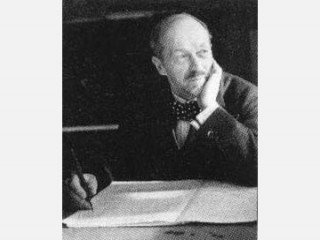
Albert Roussel biography
Date of birth : 1869-04-05
Date of death : 1937-08-23
Birthplace : Tourcoing, France
Nationality : French
Category : Famous Figures
Last modified : 2010-11-13
Credited as : Composer, ,
Albert Roussel was one of the most important French composers of his time. His early compositions reflect the main styles of the day; his later works were more advanced than those of his contemporaries.
Albert Roussel was born in Tourcoing, a town close to the Belgian border, where his grandfather was mayor. Destined for a career in the navy, he studied at the College Stanislas in Paris and joined the service in 1887. After he was commissioned, he served several years at sea, mostly in the Far East.
Roussel started composing while on his long voyages, and when he received encouragement for his efforts, he resigned his commission in 1894 and went to Paris to study composition at the relatively advanced age of 25. He entered the newly established Schola Cantorum, where he studied with Vincent d'Indy, its founder. D'Indy was conservative in that he held out against Claude Debussy's impressionism and based his instruction on a thorough knowledge of earlier musical styles.
Roussel's first published composition, a piano piece, appeared in 1898. In 1902 he became a teacher of counterpoint at the Schola, a post he held until 1914, when he resigned to enter the French army during World War I. He served as a transportation officer and saw duty at Verdun and the Battle of the Marne. When his health broke down, he returned to Paris, where he spent the rest of his life.
The best known of Roussel's early works is the ballet Le Festin de l'araignee (1912; The Spider's Feast), a skillfully orchestrated tone poem, somewhat reminiscent of Camille Saint-Sans's music in the transparency of the writing. This was followed by a large ballet-opera, Padmavati (1914-1918), based on an Indian legend and employing Indian melodies and scales, a result of Roussel's visits to the East as a naval officer. His ballet Bacchus et Ariane (1930) reflects the sumptuousness of Sergei Diaghilev's Ballets Russes that influenced so many composers of the time. This rich score shows Roussel's mastery of the impressionist idiom.
Roussel's later compositions reveal other ideals. Already in the Suite in F (1926) and in his Third and Fourth Symphonies (1930 and 1934) he wrote neoclassic pieces, shown in their avoidance of programs, economy of means, clarity of form, 18th-century textures, and driving rhythms. Igor Stravinsky was the chief exponent of neoclassicism, and Roussel was one of its principal exponents. In these compositions the astringent harmonies, wide-ranging melodies, strong rhythms, and bitonality bring Roussel close to the younger composers of the time.
It has been said that Roussel "possessed every quality but that of spontaneous invention." Even though he was not a pathbreaker, he was one of the most important French composers of the first half of the 20th century.
Roussel is discussed in Aaron Copland, The New Music, 1900-1960 (1941; rev. ed. 1968); Wilfrid Mellers, Studies in Contemporary Music (1947); and Joseph Machlis, Introduction to Contemporary Music (1961).
















